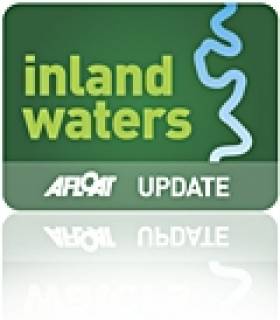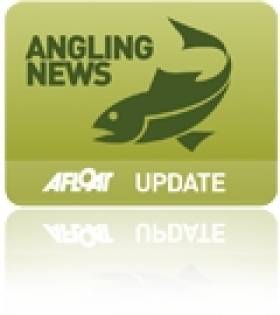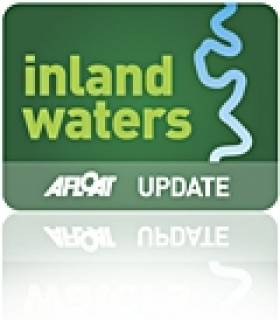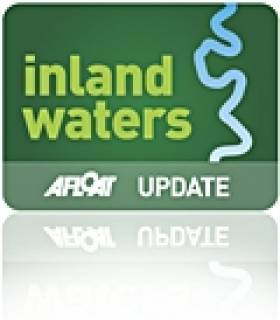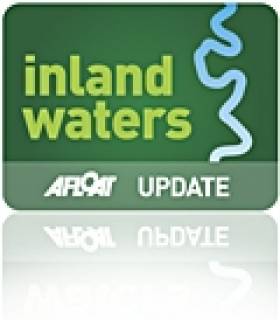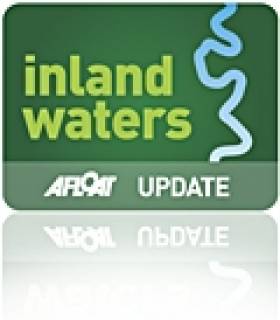Displaying items by tag: inland waterways
Breeding White-Tailed Eagles Protected on Lough Derg
Waterways Ireland has been advised that protected White-tailed Eagles are present and breeding on Bushy Island, Lough Derg at Mountshannon, a popular boating spot.
To protect and minimise disturbance to nesting White-tailed Eagles in the area, masters of vessels are requested to observe a voluntary exclusion zone by not encroaching within 250m of the island and to proceed directly in and out of Mounsthannon harbour without stopping near the island, particularly between the months of May and August inclusive.
Masters should note that deliberate disturbance to nesting birds is illegal under the Wildlife Act (1976).
#Angling - Inland Fisheries Ireland (IFI) has successfully prosecuted two men for taking more than the legal amount of coarse fish on Lough Derg.
Roman and Vytas Maslauskas, brothers originally from Lithuania but living in Ireland for the last eight years, appeared before Killaloe District Court where they were fined €500 each and were also disqualified from holding a driving licence for a period of six months. Both men have two weeks within which to lodge an appeal.
Last year IFI fisheries officers carried out a surveillance operation on the basis of reports received from both the public and local anglers on Lough Derg. The Maslauskas brothers, who were fishing mainly for perch from a boat, were doing so in manner that did not appear to be for recreational purposes. The anglers were capturing large numbers of fish using rod and line but had the aid of a fish finder on board the boat also.
The two men were apprehended at the lower end of the lake at the slipway in Ballina. Their boat and a large quantity of fishing equipment were seized during the capture. Some 32 perch were also seized, of which eight were over the 25cm size limit for coarse fish. Two vans were used in the operation for transporting the fish and equipment.
In his comments at the end of the case, Judge John Durkan said: “Our inland waters are of the most valuable in Europe and need to be well protected”.
He added that those who abuse them must face serious consequences.
“Protecting our fisheries is never an easy task,” said Minister Fergus O’Dowd, minister with responsibility for inland fisheries, at the outcome of the prosecution. “I commend the work of the Inland Fisheries Ireland staff, the Gardaí and of course the anglers and members of the public who made this prosecution possible.
“Working together you have helped the environment and the potential of Lough Derg to generate a better return economically and socially to the local community.”
IFI describes Lough Derg as “a mixed fishery which holds good stocks of coarse, pike and trout” and “a valuable natural asset to the local economy as it attracts both national and international anglers and visitors”.
IFI Limerick director Amanda Mooney commented that the ruling “sends out a strong message that our wild fish populations must be protected. IFI have invested in multi-lingual angling guides which detail and explain coarse fish by-laws. There is no longer an excuse of not knowing what rules apply.”
#InlandWaterways - Waterways Ireland is advising masters and users of the Shannon Navigation that a triathlon event will take place on Saturday 8 June in the environs of Portrunny Harbour.
The swimming course will be laid out adjacent to the moorings in the harbour, and will be active from 11.30am till 1pm on the day.
Swimmers on the course will be accompanied by a safety boat and kayaks.
Masters are requested to give the swimmers a wide berth and to navigate at slow speed and with a low wash when passing the area, and to heed any instructions or advice given by the event marshals.
English Anglers Take Top Spots At Lough Erne Classic
#Angling - London angler Peter Vasey topped the pack at the Waterways Ireland Classic Fishing Festival in Fermanagh recently, according to the Impartial Reporter.
Vasey's total catch across two sections at Crom on Upper Lough Erne - weighing in at an impressive 39.51kg - bagged him the £5,000 (€5,944) top prize, as well as a crystal chalice and a Diawa rod and reel.
The top three places all went to mainland Brits, with the highest placing local being Nick Seddon of Enniskillen who finished fifth overall.
This was the 10th year that Waterways Ireland has sponsored the Classic, which also featured top-flight angling action in the four-man team event.
The Impartial Reporter has more on the story HERE.
#InlandWaterways - Minister Fergus O'Dowd today (3 May) helped launch a new pilot scheme by Inland Fisheries Ireland (IFI) through which angling clubs and organisations can access funding to undertake sustainable development works in the Midland Fisheries Group permit area.
The Midland Fisheries Fund has an initial allocation of €50,000 which has been created from angler contributions set aside from the permit income received by IFI in the Midlands Fisheries Group area. The scheme, which is similar in design to the Salmon Conservation Fund, will allow for habitat improvement but importantly also includes angling development projects in Midlands waterways.
Successful applications will be provided with technical assistance to help them become reality and will foster links between the fishery owners, State agencies and land owners.
The application process itself, says IFI, "will instill confidence in project promoters who are often apprehensive due to the complicated nature of forms and permissions".
The scheme is exclusive to the Midland Fisheries Group area and is only open to clubs in that area.
Minister O'Dowd said at the launch: "This fund reaffirms IFI’s objective to facilitate stakeholders to undertake sustainable development works. These works will enhance and improve fisheries habitats and angling tourism potential and the contribution the inland fisheries resource makes to the economy."
The minister - who is currently undertaking a public consultation around the country in relation to the review of fisheries legislation - said he was encouraged by the angling stakeholders' enthusiasm, knowledge and interest in protecting, managing and developing the resource.
"This scheme encapsulates the partnership approach between IFI and its stakeholders, ensuring projects are environmentally sustainable, undertaken with the appropriate permissions and guidance and developed by local angling clubs for the benefit of locals and tourists alike," he said.
An information evening on the Midland Fisheries Fund will take place in Lough Owel Angling Centre on 14 May at 6.30pm.
Application forms for the fund are available online HERE. The closing date for receipt of application forms is 15 June 2013.
Meanwhile, the North South Ministerial Council (NSMC) has backed an initiative for the Loughs Agency to support the Carlingford Oyster Festival this August.
The Aquaculture and Marine sectoral meeting held in Carlingford this morning was attended by Minister for Natural Resources Pat Rabbitte, NI Minister for Rural Development Michelle O’Neill, Minister Fergus O’Dowd and NI Minister Nelson McCausland, who were all keen to endorse the proposals of the Loughs Agency to support the festival.
Taking place from 8-11 August, the festival has been developed by the Carlingford Cooley Tourism Association as a family-oriented event that showcases locally produced oysters and seafood. The agency will work in partnership with the local festival organisers on the annual event which attracts large numbers of visitors to the Carlingford area.
Minister O'Dowd said the festival “offers a real opportunity to showcase local produce and bring an international focus on Carlingford Lough as a production area of distinction for excellence seafood."
The ministers were also keen to emphasise that the tourism and visitor potential of the lough area should also benefit from a strong and vibrant oyster festival featuring as an attractive occasion on tourism and event calendars across the island and internationally.
Waterways Ireland wishes to advise all users that an extension to the existing mooring facility at Coosan Point is presently being installed at the southern end of this facility.
As such, this end of the mooring is considered to be a construction site and users are requested to note and take heed of the various warning signs.
Mooring on the new extension is prohibited until it is fully installed.
Diesel Fuel Availability on Ireland's Inland Waterways
As far as I can see, there are only seven places on the Irish inland waterways where you can park your boat at a diesel pump and fill up with marked gas oil (green diesel) from a seller who is legally allowed to sell it to you. All seven are on the Shannon; at time of writing (19 March 2013) there were none on the Grand Canal, Royal Canal, River Barrow, Erne (the part in the republic) or Shannon–Erne Waterway.
Behind this is a scheme [TinyURL http://tinyurl.com/bw29twk] introduced in 2012 by the Revenue Commissioners:
From 1st of October 2012, Section 101, of the Finance Act, 1999 (as amended by the Finance Act 2012) requires all Marked Fuel Traders who produce, sell, deliver or deal in, or keep for sale or delivery, any marked gas oil or marked kerosene to take out a Marked Fuel Trader's Licence. A separate Licence is required for each premises or place from which a trader operates.
Since last October, anyone selling or delivering green diesel, or keeping it for sale or delivery, should have applied for a Marked Fuel Trader's Licence, which costs e250 a year. Revenue requires regular returns of "oil movements".
Revenue has been publishing lists of holders of those licences and I've been reading them every week. At first, I could identify no Shannonside fuel retailers, so I checked with Revenue to make sure that the scheme did apply to private pleasure craft; it does, and I have heard that Revenue has already visited at least one boatyard.
The first Shannon fuel-seller to get a licence was Ciaran Fallon of Rooskey Craft & Tackle at Rooskey Quay. The other six licence-holders are CarrickCraft at Carrick-on-Shannon and Banagher, Emerald Star at Carrick-on-Shannon and Portumna, Hanley's Marina at Ballyleague (opposite Lanesborough) and Quigley's at Killinure on Lough Ree.
At time of writing, there is no licensed seller north of Carrick or south of Portumna. However, I may not have identified all the waterways fuel sellers correctly, and I would be happy to have my errors corrected. Updated lists of licensed marked fuel traders can be downloaded from http://www.revenue.ie/en/tax/excise/.
NI Minister Greenlights Ulster Canal Restoration
#InlandWaterways - NI Environment Minister Alex Attwood has finally announced planning permission to restore part of the historic Ulster Canal that has not been used since 1929.
The original Ulster Canal was completed in 1841 and linked the Erne System to Lough Neagh with a 93km navigation route. It was last used for trading boats in 1929 and officially closed two years later.
The application is to restore 14km of the navigational route in total - 5.5km or river navigation from Quivvy Lough to Gortnacarrow and 8.5km of canal from Gortnacarrow to Clones.
This will involve construction of the existing canal route and tow paths for public access on both banks. New road bridges are to be constructed at Derrykerrib, Wattle Bridge, Gortnacarrow and Clonfad/Munilly with three farm accommodation bridges.
The plan is to restore two existing canal bridges and a double lock at Gortnacarrow that will facilitate a rise from the River Finn to the canal section. A mooring of 170m with 32 car parking spaces and public toilets will be provided at Gortnacarrow. A picnic area and a further 20 parking spaces will be provided at the new bridge at Clonfad/Munilly.
Minister Attwood said: “The Ulster Canal restoration project has been a key heritage and tourist attraction for a long time, which has gathered momentum since the late 90s. Today is a turning point for the project. I hope the Planners’ green light means the project can accelerate.
“This is an example of cross-border initiatives working and working well. It follows from my announcement to give planning permission to the bridge at Narrow Water, linking Warrenpoint and Omeath.
“This cross-border project will be a boost for the people of Fermanagh, Cavan and Monaghan. It will re-open a historic waterway that has not been used for over 80 years and offers huge opportunities for regeneration and leisure-related activities for the entire region.”
Four accompanying applications for Listed Building Consent to carry out works to repair and restore three listed bridges and works to the Clones Aqueduct have also been approved.
Northern Ireland's Department of the Environment consulted Fermanagh District Council on its opinion to approve this application on 18 April 2013.
Monaghan County Council and Clones Town Council have signalled that planning approval should be granted for the Repubic side of the canal - although moves have been slow on that front.
Despite confirmation from Minister for Arts, Heritage and the Gaeltacht Jimmy Deenihan in April 2012 that the "main thrust" of waterways refurbishment is still focused on the reopening of the Ulster Canal, no significant moves have been made in the year since that statement, which came some months after a U-turn in Government funding for such projects.
Royal Canal 41 St. Level Mullawornia and Coolnahinch Bridge Closure for Leak Repairs
#grandcanal – Waterways Ireland advises masters and owners that the 41st level of the Royal Canal between Mullawornia and Coolnahinch Bridge will be closed from Monday 29th April to Friday 17th May. This is required to carry out emergency leakage repair works.
MARINE NOTICE No. 25 of 2013 ERNE NAVIGATION UPPER LOUGH ERNE TEMPORARY CLOSURE OF PUBLIC JETTY AT CROM
Waterways Ireland wishes to advise masters and owners that the mooring jetty at the above location has been temporarily closed to the public to facilitate emergency repair works.
Waterways Ireland apologises for any inconvenience caused during these works.
Charles Lawn
Lt Cdr (rtd)
Inspector of Navigation
19 Apr 2013
Tel: 00 353 (0)90 6494232 Fax :00 353 6494147




























